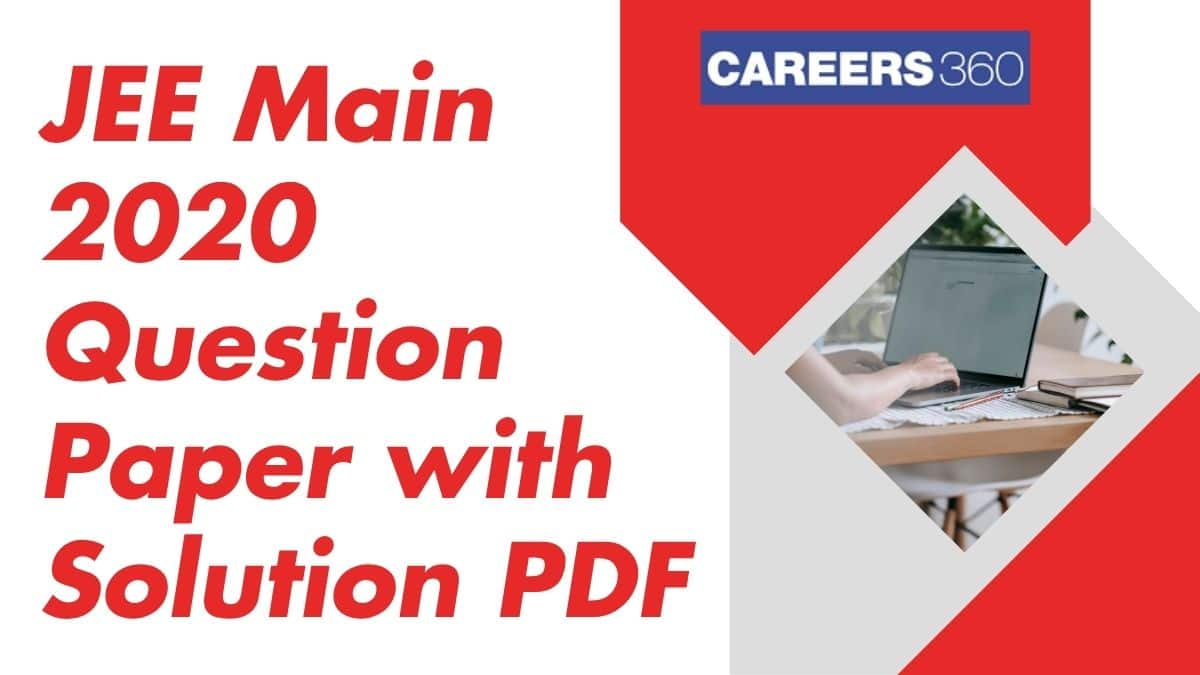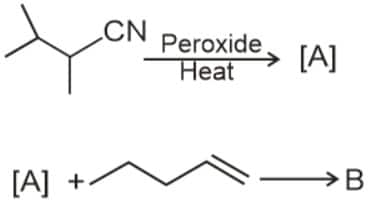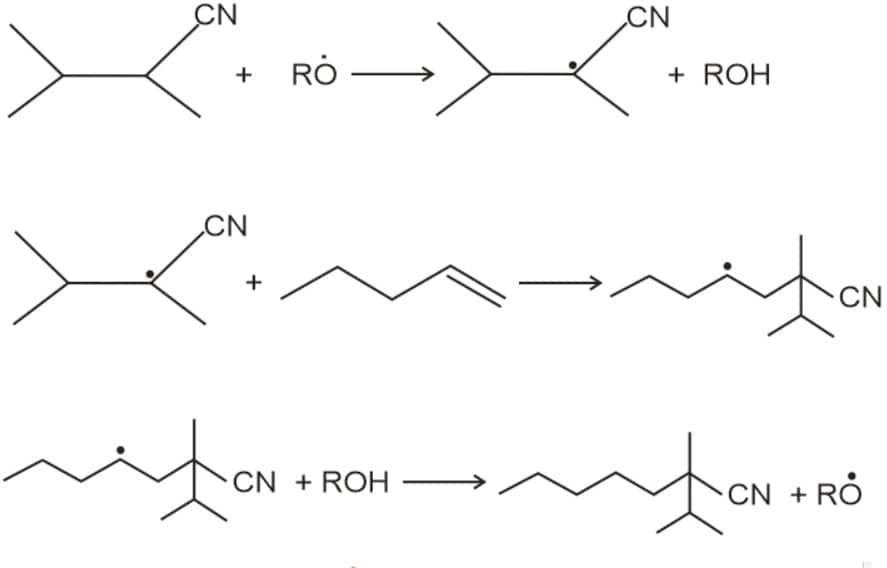Amity University-Noida B.Tech Admissions 2026
Among top 100 Universities Globally in the Times Higher Education (THE) Interdisciplinary Science Rankings 2026
JEE Main 2020 Question Paper with Solution PDF - The National Testing Agency uploaded the JEE Main question paper with solution 2020 on the official website, jeemain.nta.nic.in. Candidates can check the question paper of JEE Main 2020 in this article. Solving the JEE Main 2020 question paper PDF is important to understand the difficulty level of the JEE Main exam, important topics, marking scheme and more. Reviewing or slovinf the JEE Mains 2020 question paper within the 3 hours (i.e. real exam duration) helps you improve your problem-solving skills. Aspirants can also download the previous year's JEE Mains question paper from Careers360. Download the JEE Main 2020 question paper with the solution pdf below.
This Story also Contains

JEE Main 2020 paper was conducted in 2 sessions (i.e. January and September) where a total number of 1200 questions were asked including all three subjects (i.e. Physics, Maths and Chemistry) from all 16 shifts. This number of questions is sufficient for aspirants aiming for JEE Main 2025 preparations for practising questions of JEE Main difficulty level. If needed candidates can also go through others JEE Main previous years questions for better understanding. The JEE Main 2020 question paper with solution pdf free download link is provided below.
In the year 2020 session 2 of JEE Main, which is usually held in April, was postponed due to the Covid 19 pandemic and was conducted in the month of September. Candidates can click the link above to download the official JEE Main Question Paper 2020 with solutions. Careers360 provides the question paper of JEE Main 2020 for both sessions on this page itself. We have also provided solutions to the questions asked in JEE Main question paper 2020. After attempting the JEE Main question paper, candidates can check their answers by using the solutions provided.
Recognized as Institute of Eminence by Govt. of India | NAAC ‘A++’ Grade | Upto 75% Scholarships
100% Placement Record | Highest CTC 54 LPA | NAAC A++ Accredited | Ranked #62 in India by NIRF Ranking 2025 | JEE & JET Scores Accepted
Since these are free resources, candidates must download them to make the most of them. JEE Main 2020 question paper when combined with other resources such as mock tests, sample papers and more practice questions makes an effective preparation strategy. Students can find the links for all the preparation resources on this page itself.
Aspirants preparing for upcoming exams can gain valuable insights into the paper pattern, difficulty level, and frequently appearing questions by referring to the JEE Main question paper pdf. Experts have explained the jee main question paper 2020 with solutions in great detail.
We have provided direct links for downloading the JEE Main sample paper pdf. Candidates must download the sample papers and practise them to strengthen their preparation for the upcoming JEE Main examination.
Students who complete the JEE Mains 2020 question paper will gain the following advantages:
Candidates will be able to revise the concepts learned during preparation by practising the JEE Main exam question paper pdf. Students can then identify topics that need more practice and strengthen their grasp on the particular subject topics.
Students can gain an understanding of the JEE Main exam pattern, the weighting of topics, and more by solving the question paper of JEE Main 2020. This acts as a better preparation strategy for the exam.
Candidates can improve their time management and exam familiarity by completing the JEE Mains question paper 2020. They can also use it to determine which sections to concentrate on to increase their accuracy and speed.
Regular practice of JEE Main Question Paper 2020 pdf with solutions can help candidates gain confidence and reduce anxiety before the exam. It will allow candidates to get the feel of the exam and get accustomed to its time limit and challenging questions.
There is a significant difference between JEE Main question papers as compared to previous years, with respect to exam syllabus, exam pattern, number of questions etc for Paper 1 (i.e. for B.E./ B. Tech). Let's discuss them one by one
JEE Main Syllabus:- Major chapters from all three subjects have been deleted from the current JEE Main Syllabus with respect to previous year JEE Main Syllabus.
Here are the details about the syllabus that is removed.
Subject | Chapter Name |
Physics | Communication System |
Physical Chemistry | States of Matter |
Surface Chemistry | |
Inorganic Chemistry | General Principles and Processes of Isolation of Metals |
Hydrogen | |
S-Block Elements (Alkali and Alkaline Earth Metals) | |
Environmental Chemistry | |
Organic Chemistry | Polymers |
Chemistry in Everyday Life | |
Mathematics | Mathematical Inductions |
Mathematical Reasoning |
The above-mentioned chapters are completely removed from the JEE Main Syllabus along with major topics from other remaining chapters also reduced.
For detailed analysis have a look at JEE Main Syllabus
Exam patterns:-
Total marks- The total marks are the same. I.e Students can achieve a maximum of 300 marks in the main exam.
No of Questions- Let's have a look at Subject wise distribution of the total number of questions for the JEE Main exams.
Subject | No of Questions | No of Questions |
Mathematics | (20 MCQs+ 5 NAT) | (20 MCQs+ 5 NAT) |
Physics | (20 MCQs+ 5 NAT) | (20 MCQs+ 5 NAT) |
Chemistry | (20 MCQs+ 5 NAT) | (20 MCQs+ 5 NAT) |
Here MCQs mean Multiple-Choice Questions and NTA means questions whose answers are to be filled in as a numerical value. So to summarize in JEE Main for section B in each subject 5 NTA-type questions are there, but candidates have to attempt all 5 of them.
1. (Subject - Physics, Chapter - Optics, Shift - 06 Sep - Evening Shift)
Question:- A double convex lens has power P and the same radii of curvature R of both surfaces. The radius of curvature of the surface of a planoconvex lens made of the same material with power 1.5 P is :




Answer- 4) 
Solution:-






Hence, The correct option is (4)
2. (Subject - Maths, Chapter - Integral Calculus, Shift - 03 Sep - Evening Shift )
Question:- If  where
where  is a constant of integration, then the ordered pair
is a constant of integration, then the ordered pair  can be?
can be?




Answer- 1) 
Solution:-
Given,


Now do the integration by parts



Hence, the answer is the option 1.
3. (Subject - Chemistry, Chapter - Hydrocarbons, Shift - 08 Jan - Morning Shift)
Question:- The major products A and B in the following reactions are:





Answer- 1) 
Solution:-
The given reaction occurs as :
![\mathrm{R-O-O-R\xrightarrow[]{\Delta}2R\dot{O}}](https://cache.careers360.mobi/media/articles/uploads/froala_editor/images/2024/7/10/1720600854881.png)

Therefore, Option(1) is correct.
Frequently Asked Questions (FAQs)
Solving previous years' question papers can help candidates identify the exam pattern, important topics, frequently asked topics, and increase their speed and accuracy.
JEE Mains 2020 examination was conducted as a computer based test and held in online mode.
Solving the previous year's JEE Main question papers was a highly effective preparation strategy. It allowed candidates to familiarise themselves with the exam pattern, question types, and concepts. It also helped assess their readiness and improve problem-solving skills.
Candidates can find the JEE Main question papers with solutions pdf of all years and sessions on Careers360 website.
Yes, the JEE Main 2020 question paper is a reliable resource for practice as it is the official examination paper.
On Question asked by student community
Hello aspirant,
If your syllabus is completed with theory , use the next 30 days only for smart revision . Make short notes and revise formulas daily for Physics , Chemistry and Maths . Solve previous year JEE Main questions topic-wise and then full mock tests every 3-4 days. Analyse mistakes properly and revise weak areas again . Avoid new topics and focus on accuracy , speed and confidence building during revision.
FOR REFERENCE : https://engineering.careers360.com/articles/jee-main-revision-strategy
Hope the details will help you.
THANK YOU
Preparing for the JEE Main in just 30 days is a challenging but achievable task if you follow a highly disciplined and strategic approach. According to the Careers360 30-day study plan , the key is to shift your focus from learning everything to mastering high-weightage topics and practicing rigorously.
During the first 15 days, prioritize topics that frequently appear in the exam.
Physics: Modern Physics, Heat & Thermodynamics, Optics, and Current Electricity.
Chemistry: GOC (General Organic Chemistry), Chemical Bonding, p-Block elements, and Solutions.
Maths: Matrices & Determinants, Sequences & Series, Coordinate Geometry, and Vector & 3D Geometry.
Study Strategy: Use NCERT for Chemistry and simplified notes for Physics/Maths. Spend 3-4 hours on each subject daily.
Short Notes: Go through the short notes you made during the first two weeks.
Flashcards: Use flashcards for inorganic chemistry reactions and physics formulas.
Mock Tests: Start giving one full-length mock test every alternate day. Analyze your mistakes immediately to avoid repeating them.
Previous Year Papers (PYQs): Solve the last 3-5 years of JEE Main papers in the actual exam time slot (9 AM–12 PM or 3 PM–6 PM) to sync your body clock.
No New Topics: Stop picking up new chapters. Focus solely on what you already know to build confidence.
Accuracy over Speed: Focus on getting the questions right rather than attempting all of them, as negative marking can significantly lower your percentile.
You can download the comprehensive day-by-day schedule, which includes specific topics to cover each morning and evening, by visiting the link : https://engineering.careers360.com/download/ebooks/jee-main-study-plan-30-days
Hello
I think your question sounds like this: "Can a candidate who passed Class 12 in 2025 and filled JEE Main Session 1 apply for Session 2 as 'Appearing' in 2026 as a fresh board candidate, and will both sessions have the same details? "
So yes, you can fill the JEE Main Session 2 as "Appearing". The information filled in Session 1 will remain exactly as it was and will not change.
Session 1 and Session 2 are treated as separate applications. There is no issue if the qualifying status is different in both sessions. During counselling, the board marks that meet the 75 rule will be considered.
Hello,
If you filled the JEE Main January form with Class 12 passed in 2025 and are planning to appear again for the Class 12 exam through HOS, there is usually no serious issue. You were eligible to apply since you had already passed Class 12. Reappearing through HOS for improvement or requalification is allowed, provided HOS is a recognized board. During counselling, your latest valid Class 12 result will be considered. Make sure you meet the 75% marks or top 20 percentile requirement where applicable. If a correction window opens, update details if needed.
Hope this has solved your query. Thank You.
Good Evening,
Yes, you are eligible for both JEE Mains and Advanced, as you completed your 12th with physics, chemistry and biology. Moreover, you passed mathematics in 2025, which makes you fit the eligibility criteria of both exams.
Aspirant, I would like to inform you that Careers360 recently launched a free mock test series for JEE students. The last date of registration is 8th January, 2026. Enroll and solve chapter wise question papers and improve you concept and assess your learning. The link to the mock test series is attached herewith. https://learn.careers360.com/test-series-jee-main-free-mock-test/
Best regards.
Among top 100 Universities Globally in the Times Higher Education (THE) Interdisciplinary Science Rankings 2026
National level exam conducted by VIT University, Vellore | Ranked #16 by NIRF for Engg. | NAAC A++ Accredited
Recognized as Institute of Eminence by Govt. of India | NAAC ‘A++’ Grade | Upto 75% Scholarships
Ranked #43 among Engineering colleges in India by NIRF | Highest Package 1.3 CR , 100% Placements
100% Placement Record | Highest CTC 54 LPA | NAAC A++ Accredited | Ranked #62 in India by NIRF Ranking 2025 | JEE & JET Scores Accepted
NAAC A+ & NBA Accredited | QS I-Gauge Gold rated University | Highest CTC 52 LPA | 300+ Companies | Avail Scholarships Application Deadline: 28th Feb’26